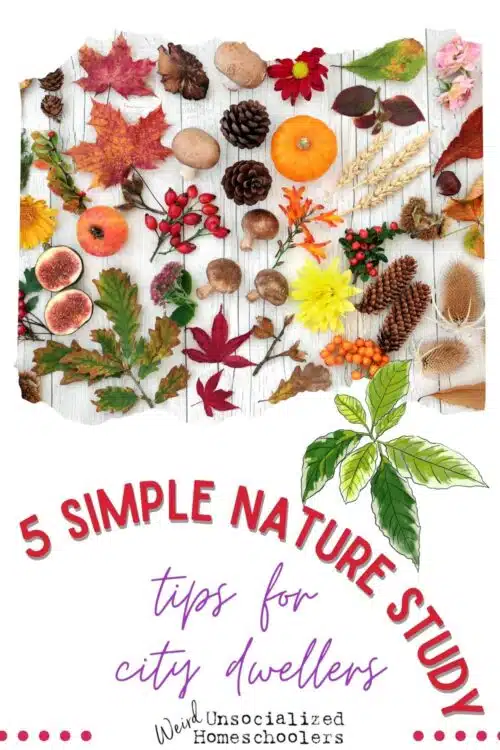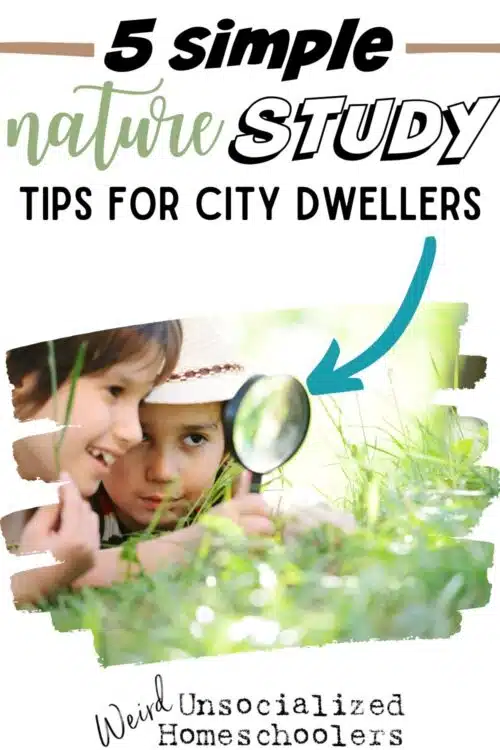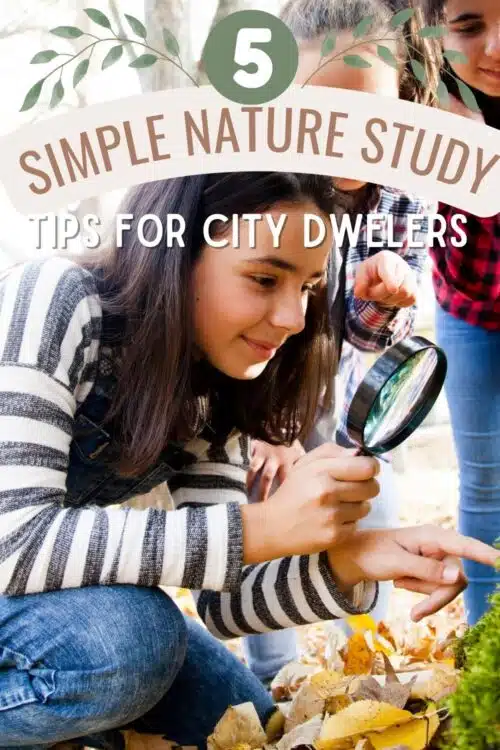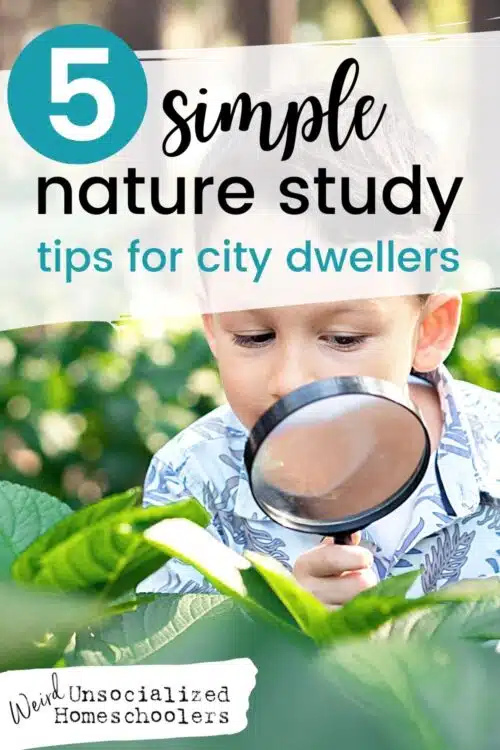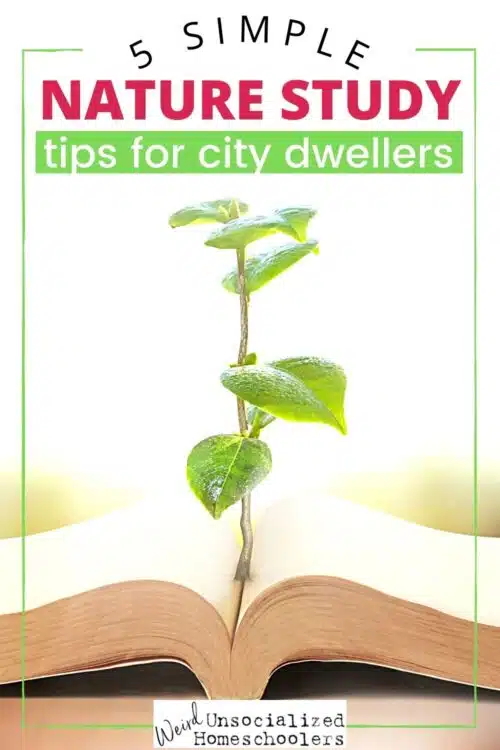5 Simple Nature Study Tips for City Dwellers
I’ll confess, with teenagers, nature study isn’t part of our regular homeschool routine. (Not that nature study isn’t just as beneficial for teens as it is for young children; we just haven’t made it a priority.)
When the kids were younger, we used to enjoy a regular weekly nature study outing. We had a membership at local nature preserve since nature study in our subdivision wasn’t terribly exciting.

This post contains affiliate links. See full disclosure policy for more details. Email and RSS feed readers may need to visit the blog to access affiliate links.
Is your idyllic nature study vision of wandering around in the woods or tromping through farmland far from your reality? If so, I’ve got some ideas! Some are those that worked for us. Others should work even if you live in the middle of the city.
Also, no matter where you live, the Handbook of Nature Study blog is, hands down, my favorite resource for nature study ideas.
1. Study what’s available.
No matter where you live, there are a few nature study subjects that are sure to be available to some degree – trees, birds, and insects. Collect and identify leaves. Observe and identify birds and insects. Collect feathers that you find and see if you can determine from which bird they came.
Try some fun tree study ideas from The Homeschool Scientist. Check out this tree unit study from The Unlikely Homeschool.
Do you live in a place where you could try a DIY bird feeder or cookie-cutter bird feeder to attract birds for observation? Or maybe you could try a suction cup bird feeder.
Try some of these insect unit study ideas as a starting place for including insects in your nature study:
- Gift of Curiosity Insect Unit Study
- The Pioneer Woman: It’s a Bug’s World (Check out the comments for additional resources.)
2. Go to nature.
As I mentioned in the introduction, we joined a local nature preserve so that we had a reliable spot to go for nature study – and one that excited us much more than our backyard!
Check your local area for resources such as:
- nature preserves
- nature trails (not as much fun as a whole preserve, but better than nothing)
- parks
- ponds
- zoos
You might have to be creative, but nature study is worth the effort – especially when you have young children. It’s good to get outside for some fresh air, sunshine, and exercise on a regular basis.
Work with what’s available to you. Take stale bread to the pond to attract ducks and birds. Look along the water’s edge for frogs and their eggs. Toss bread or popcorn into the water for the fish.
Choose a spot to observe for a year – the same pond or the same tree in the park, for example. Each time you visit, sketch your spot and note the changes that you observe throughout the year.
You might also check with local colleges to see if they have any helpful resources available to the public.
3. Bring nature to you.
Bring nature home to study. No, don’t go out and capture random creatures! Instead, consider ordering an ant farm or butterfly house. You can even try a roly-poly farm.
Consider unusual pets such as snakes, lizards, mice, or crabs. Just do your research first and make sure you’re prepared to care for them.
You can also try getting some frog eggs or tadpoles to watch their metamorphosis into frogs. You may be able to find eggs near a pond – just make sure it’s legal to take some – or check with a pet store about tadpoles.

4. Make use of the Internet.
Supplement your nature study with internet resources. Try live streaming nature study webcams. (The previous link ends in a plug for home security systems, but they really have put together a great collection of links to various nature webcams.)
Watch documentaries on your Netflix or Amazon Prime account. Don’t forget about YouTube! You can find both National Geographic and National Geographic Kids channels with some fantastic resources.
Check out your state 4-H website. They often have some fantastic resources such as this virtual bug collection from the Oklahoma 4-H page.
5. Nature study pen pals.
Finally, consider looking for some nature study pen pals. We put together a nice rock collection by doing a rock exchange when my kids were younger.
Nature study pen pals can agree to exchange photos and videos of birds, insects, trees, and animals that each finds in their area. You can also send packages with specimens such as feathers, leaves, flower, rocks, or preserved insects (preferably those that have died of natural causes).
You may wish to preserve leaves before mailing. They’ll hold up better in shipping, and it will be a fun science project for your family.
Each family can either research their findings and send those along or just send the pictures and videos for the receiving family to investigate.
Even if you live somewhere that seems extremely unconducive to regular nature study, there are ways to ensure that it happens.
If you live in an area that isn’t especially nature-study-friendly, what workable solutions have you discovered?
Kris Bales is a newly-retired homeschool mom and the quirky, Christ-following, painfully honest founder (and former owner) of Weird, Unsocialized Homeschoolers. She has a pretty serious addiction to sweet tea and Words with Friends. Kris and her husband of over 30 years are parents to three amazing homeschool grads. They share their home with three dogs, two cats, a ball python, a bearded dragon, and seven birds.



